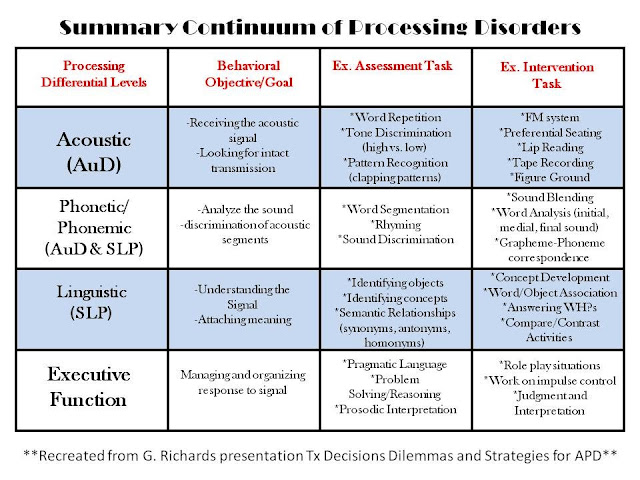ASHA Schools Conference 2013: Tx Decision Dilemmas/Strategies for APD: Part 2-Treatment!
Gail Richard, PhD, CCC-SLP, presented on Treatment Decision Dilemmas and Strategies for Auditory Processing Disorders (APD) in July at this year’s ASHA schools conference. Below is a recap of what I found interesting and important to share from this presentation. I broke this up into two blog posts. This is part two, focusing on treatment of APD! You can find part one here!
**Note: The two visuals in this blog post are recreations from Dr. Richards presentation. I was unable to scan, save and share her slides without affecting clarity therefore I had to recreate them here. Please understand I DO NOT claim any intellectual property for these visuals and if they are shared MUST be credited to Dr. Gail Richards for her work.**
1. ASHA had committee independently review the current APD treatment programs focused primarily on specific auditory skills (ex. Tomatis, Integrated Listening Systems (iLS), Fast ForWard) and found that growth in the focused skill was noted, however there was no growth in other areas (language, academics, memory, etc.).
2. Therefore, it is imperative we create FUNCTIONAL treatment plans that are individualized for each student.
3. Review of Earobics (which is considered more language-based) demonstrated improvements in early literacy skills (phonetic awareness, auditory processing, phonics, specifically with recognizing and blending sounds (decoding), rhyming and discriminating phonemes within words. Therefore, this could be a possible treatment for student who have phonological awareness deficits.
4. HearBuilder Auditory Memory (from Super Duper)-grades K-8th-is a program that teaches memory strategies such at chunking , melody, grouping, etc.-pilot study shows positive results in auditory memory skills (1 hr/wk for 8/wks). This could be a possible treatment program for auditory memory skills.
1. Management + Remediation = Effective Treatment Strategies
(of acoustic signal) (of skills)
2. Ask yourself “If I do treatment on these specific auditory skills will that improve my students language?” If the answer is no, then you need to rethink your treatment plan.
3. As stated above, programs that are auditory based treatment (Tomatis, iLS, Fast ForWard) only focus on an isolated skill and will NOT improve other areas of language.
4. Goal of treatment: should always be functional language objectives as they will yield more functional outcomes.
5. Find out where the student is on the APD continuum:
-If the student can repeat after you, the sounds are being perceived (meaning the auditory processing is intact and transition area and language processing is the area in need of further assessment and possible treatment).
-If the area of need is in the “transition area”: SLPs will dx the student with “deficits in phonology or phonological awareness, while the AuD will dx the student with APD. And treatment would focus on phonological awareness skills (sound discrimination, blending, segmenting, rhyming, etc.).
-If the student can demonstrate phonological awareness skills independent of meaning, than language processing is the area of need.
6. If treatment is focused on acoustic signal issue: bottom-up approach is often used (acoustic perception via amplification and signal management, acoustic knowledge, and stress verbal production and output )
7. If treatment is focused on comprehension/coding issue: top-down approach is often used (knowledge of language, interpreting word meanings, semantic knowledge, stress comprehension and intake of information)
That is Dr. Richard’s presentation in a nutshell, so to speak! I hope you enjoyed the information. I know I enjoyed learning it!




No comments yet.